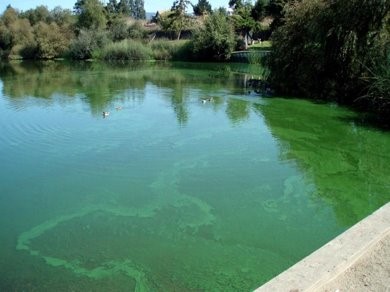
Freshwater and Estuarine Harmful Algal Bloom (FHAB) Program

See an algae bloom? Report an algae bloom
CA HABs Portal Bloom Report Form HAB Incident Web Map
Recent Advisories and Notifications
- August Harmful Algae Bloom (HAB) Advisories: Bridgeport Reservoir, Lake Hemet, Clear Lake, Lake Crowley
- Announcement - Harmful Algal Blooms: How to recreate safely in the summer
- FHAB Response Plan and Key Resources
- Durable HAB signs are available, contact cyanoHAB.reports@waterboards.ca.gov to learn how to obtain general awareness and advisory signs.
- FHAB Program 2023 Annual Report now available
Overview
Freshwater and estuarine HABs (FHABs) have occurred in California since at least 1925, when a dog fell ill after drinking water at Clear Lake -- the first report of a FHAB dog sickness in the state. Now almost one hundred years later, FHABs continue to occur in lakes, reservoirs, and rivers throughout the state and during all months of the year. Blooms occur in high elevation lakes in the Sierra Nevada mountains down to coastal estuaries, where cyanotoxins are exported into the marine environment. They also occur in sensitive desert landscapes where water is already a scarce resource. In parts of the state, environmental conditions, particularly drought conditions, promote cyanobacterial blooms that persist through the winter, making FHABs a year-round issue in California. When cyanobacteria bloom and produce cyanotoxins they threaten drinking water supplies, wildlife, domestic animals, and human health. With greater than 3000 lakes, 190,000 river miles, rainfall spanning deserts to temperate rainforests, and over 40 million inhabitants, the diversity of environments in California forms a complex social and ecological context within which cyanobacteria bloom.
The Water Boards first began to address HAB prevalence in 2006 when it supported the formation of the Blue Green Algae Work Group with many other concerned entities, later the group was renamed the California Cyanobacteria Harmful Algal Bloom Network (CCHAB). An initial product of this group was the Voluntary Guidance Document that describes a standardized framework to HAB response in recreational waterbodies (original release 2010, updated 2016).
FHAB Program
The SWAMP began developing the FHAB program in 2014. SWAMP prepared the California Freshwater HAB Assessment and Support Strategy to articulate the goals of the program to provide response, assessment, and communication to statewide occurrences of HABs. Since that time, the program has developed systems and infrastructure for sampling and tracking bloom events, created informational resources for agency staff and the public, and collaborated with partner entities to establish voluntary guidance thresholds for public health postings in recreational waterbodies.

In 2016, the FHABs report tracking system was launched. Voluntary bloom reports (Bloom Report Form) from the system are posted online through an public interactive map showing the location and magnitude of blooms across the state. The FHAB Program has observed in recent years that FHABs are increasing in incidence, duration, and toxicity statewide and as a result, human, domestic animal (particularly dogs and livestock), and wildlife health impacts are increasingly prevalent. The temporal occurrence of FHABs is also increasing from predominantly summer blooms to year-round blooms in some areas.
As the infrastructure and resources for bloom responses has become better developed and comprehensive, the FHAB program is creating guidelines for ambient FHABs monitoring and refining the satellite imagery tool that remotely screens for potential HABs in larger waterbodies in the state.
In September 2019, the Governor signed Assembly Bill (AB) 834 (Freshwater and Estuarine Harmful Algal Bloom Program). AB 834 requires the State Water Board to establish a formal program to protect water quality and public health from harmful algal blooms in consultation with state and federal agencies, and California Native American tribes. The major responsibilities under the bill include six components involving: event response, statewide assessment and monitoring, risk assessment, research, outreach and education, and reporting.
In early 2021, SWAMP funded and closely collaborated with the Southern California Coastal Water Research Project (SCCWRP) to release the report, California Water Boards’ Framework and Strategy for Freshwater Harmful Algal Bloom Monitoring (Monitoring Strategy). This document lays the foundation for how to develop an ambient monitoring program for freshwater and estuarine HABs in California, a priority that was identified in SWAMP’s 2016 FHABs Assessment and Support Strategy, but that had not been implemented by SWAMP. When work on the Monitoring Strategy began, AB 834 had not been approved and the available resources for FHABs monitoring were not yet established. Therefore, the Monitoring Strategy was written as a conceptual document to comprehensively consider all the monitoring options for the Water Boards. The Monitoring Strategy proposes many programmatic and special study recommendations for the Water Boards including efforts to support implementation of monitoring, research, and risk assessment objectives under AB 834.
In response to AB 834, a Budget Change Proposal (BCP) was submitted and approved in 2020 to add 5 permanent staff positions and annual contracting funds. The staff positions are distributed among the State Board, North Coast Regional Board, Central Valley Regional Board, and Lahonton Regional Board. These staff will work to implement the mandates of AB 834 at the State and Regional scales.
Program Strategic Planning Documents
- Best Practices to Employ Satellite Remote Sensing to Assess Freshwater Harmful Algal Blooms in Inland Water in California (March 2025)
- CA Water Boards’ Framework and Strategy for Freshwater Harmful Algal Bloom Monitoring (2021)
Reports
- Report to the Legislature (2021)
- 2022 Report to the Legislature, including recommendations for additional programmatic actions and gaps to implement
- 2022 FHAB Program Gap Assessment in meeting legislative requirements
- 2023 Water Code Section 13182(a) FHAB Program Annual Report


